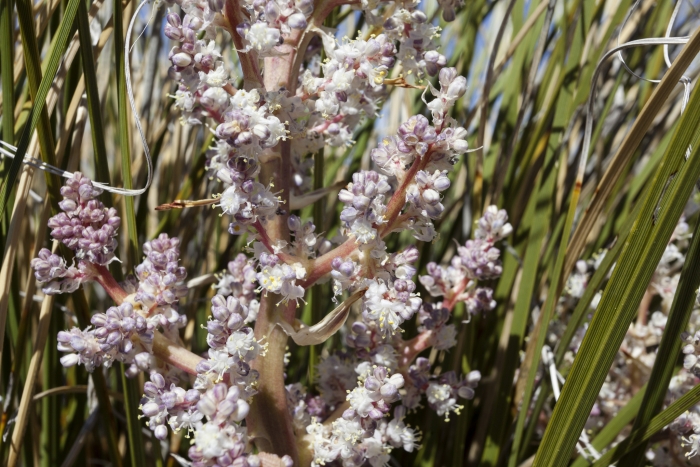Texas Bear-Grass
(Nolina texana)
Texas Bear-Grass (Nolina texana)
/
/

Cecelia Alexander
Public Domain
Image By:
Cecelia Alexander
Recorded By:
Copyright:
Public Domain
Copyright Notice:
Photo by: Cecelia Alexander | License Type: Public Domain | License URL: http://creativecommons.org/publicdomain/zero/1.0/ | Rights Holder: Cecelia Alexander | Publisher: iNaturalist | Date Created: 2017-03-25T14:24:02-07:00 |











































































Estimated Native Range
Summary
Nolina texana, commonly known as Texas Bear-Grass, is an evergreen subshrub or shrub native to the rocky slopes, canyons, and open areas of the Chihuahuan Desert and the Edwards Plateau in Texas and Northern Mexico. It typically grows to a height of 1-2 feet (0.3-0.6 meters) and a width of 2-3 feet (0.6-0.9 meters), forming dense clumps of narrow, leathery leaves that can add texture to garden compositions. The plant produces tall, narrow panicles of small, creamy-white flowers in late spring to early summer, which are modestly showy and attract pollinators.
Texas Bear-Grass is valued for its drought tolerance and architectural form, making it a suitable choice for xeriscaping, rock gardens, and as an accent plant in water-wise landscapes. It is also used in native plant gardens to provide year-round interest. This plant thrives in full sun to part shade and prefers well-drained soils, tolerating a range of soil types from sandy to rocky. While generally low-maintenance, it may require occasional grooming to remove old foliage. Texas Bear-Grass is not known to have aggressive roots or significant disease problems, but it can be susceptible to root rot if overwatered. It is also deer resistant, which is a bonus for gardeners in areas with high deer populations.CC BY-SA 4.0
Texas Bear-Grass is valued for its drought tolerance and architectural form, making it a suitable choice for xeriscaping, rock gardens, and as an accent plant in water-wise landscapes. It is also used in native plant gardens to provide year-round interest. This plant thrives in full sun to part shade and prefers well-drained soils, tolerating a range of soil types from sandy to rocky. While generally low-maintenance, it may require occasional grooming to remove old foliage. Texas Bear-Grass is not known to have aggressive roots or significant disease problems, but it can be susceptible to root rot if overwatered. It is also deer resistant, which is a bonus for gardeners in areas with high deer populations.CC BY-SA 4.0
Plant Description
- Plant Type: Subshrub, Shrub
- Height: 1-2 feet
- Width: 2-3 feet
- Growth Rate: Moderate
- Flower Color: White
- Flowering Season: Spring, Summer
- Leaf Retention: Evergreen
Growth Requirements
- Sun: Full Sun, Part Shade
- Water: Low
- Drainage: Medium, Fast
Common Uses
Bee Garden, Butterfly Garden, Deer Resistant, Drought Tolerant, Erosion Control, Fire Resistant, Fragrant, Low Maintenance, Potted Plant, Showy Flowers, Street Planting
Natural Habitat
Rocky slopes, canyons, and open areas of the Chihuahuan Desert and the Edwards Plateau in Texas and Northern Mexico
Other Names
Common Names: Texas Sacahuiste, Texas Sacahuista, Bunch-Grass, Palmilla Texana, Sacahuista
Scientific Names: , Nolina texana, Nolina affinis, Nolina texana var. compacta, Beaucarnea texana, Nolina erumpens var. compacta, Nolina texana var. texana,
GBIF Accepted Name: Nolina texana S.Watson